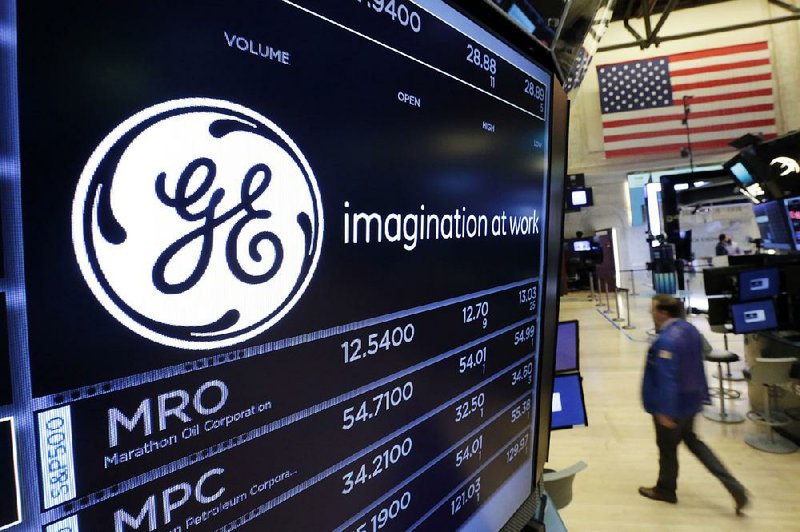General Electric, the nation's largest industrial company, cut its dividend Monday, only the second time it has done so since the Great Depression.
The company announced before the start of stock trading that it would reduce its quarterly payout by half, to 12 cents a share from 24 cents a share. Shares of GE are down 38 percent this year and trading at five-year lows.
The dividend cut is the most emphatic move that John Flannery, GE's new chief executive, has made since he took over in August. It is part of his broader plan to streamline the company by cutting costs and focusing on fewer businesses.
Last month, when GE reported disappointing financial results, Flannery said the company would sharpen its focus on fewer industrial businesses and shed at least $20 billion in assets over the next two years.
According to S&P Global, GE will save $4 billion a year.
There may well be more. Flannery added detail to his plans for GE's future in a presentation Monday. The units to be disposed of, he said, would probably include the lighting and railway locomotives divisions, and an industrial solutions business that sells energy-distribution and monitoring equipment. Ten smaller assets, which Flannery declined to identify, will also be shed.
Flannery said GE was also exploring "exit options" for its 62.5 percent stake in Baker Hughes, a large oil-field equipment maker.
Besides Flannery and the company's chief financial officer, Jamie Miller, executives from only two GE units -- jet engines and electrical-power generators -- made presentations.
Emphasizing his belief in the vitality of a smaller GE -- and nodding to products like electric generators, jet engines and medical-imaging equipment -- Flannery accompanied his presentation with slides that said the company would continue to "power the world," "transport people safely" and "save lives."
Yet his address also mentioned other businesses he described as "fundamentally strong," including wind turbines for renewable energy and the company's railroad-equipment unit, which is expected to be sold off over the next few years.
GE had nearly 300,000 employees worldwide at the end of last year. The impending sales of several businesses and other cost-cutting initiatives will undoubtedly leave it a smaller company.
Yet Flannery portrayed the path ahead not as one of retreat but as one of opportunity, for GE workers and for the company's investors.
"We will produce results that our owners, and that we, will be proud of," he said. "This is our time to reinvent the company."
Since becoming chief executive, Flannery has moved swiftly to roll back spending. He grounded the corporate jet fleet, stretched out the construction schedule for GE's new headquarters in Boston, closed several international research-and-development labs, and trimmed the workforce in units like GE Digital, the company's ambitious effort to become an industrial-software powerhouse.
Flannery had previously announced an acceleration of cost-cutting goals established under his predecessor, Jeffrey R. Immelt, who targeted $1 billion annually this year and next. Flannery doubled the 2018 goal to $2 billion in expenses to be eliminated.
GE's stock price, which had fallen by 35 percent as of Friday, was down more than 5 percent in midday trading Monday after the announcement that the dividend would be cut. It closed down $1.47, to $19.02
GE last cut its dividend in 2009 in the throes of the financial crisis, when it was the nation's largest nonbank financial institution. That dividend cut was the first since the Great Depression for a company long revered as a model of enlightened management.
The move announced Monday reflects the company's declining cash flow, but it also underscores Flannery's decision to further pare GE's portfolio of businesses. The total dividend payout had been more than $8 billion a year, among the most costly for U.S. corporations. But the cash flow to cover that bill has faltered.
When GE reported its third-quarter earnings last month, it said cash flow for the year would be about $7 billion, down from an initial target of $12 billion to $14 billion.
GE executives emphasized that this year's cash shortfall was attributable to two businesses -- the oil-field equipment unit, which showed persistent weakness, and its power-turbine business, which had a surprisingly sharp decline. Both units are expected to improve their performance next year, executives said, lifting GE's cash flow in the process.
Still, Flannery and his team cautioned Monday that 2018 would be "a reset and stabilization year."
And given the slimming-down strategy, GE will be a shrunken company, with fewer businesses to contribute cash in the future.
Information for this article was contributed by The Associated Press.
Business on 11/14/2017
